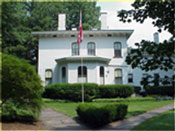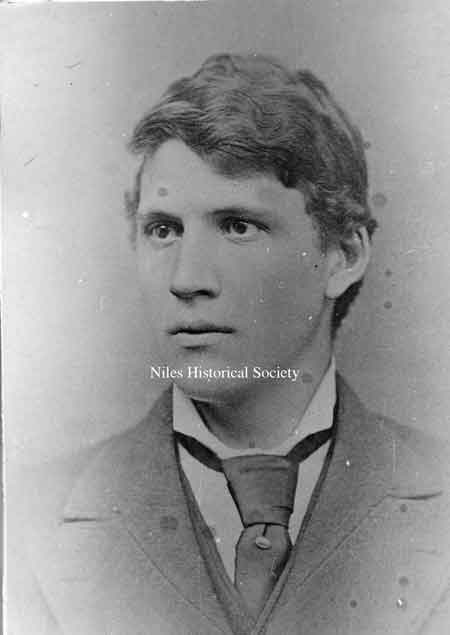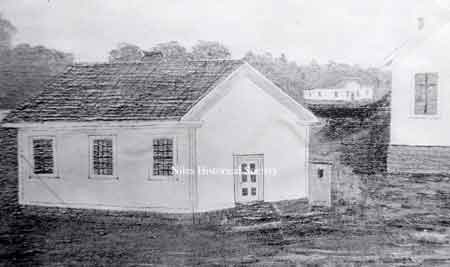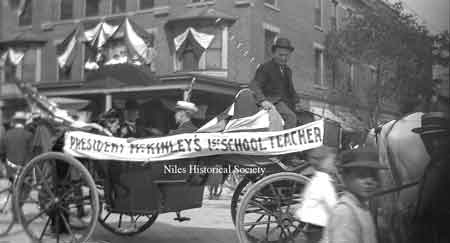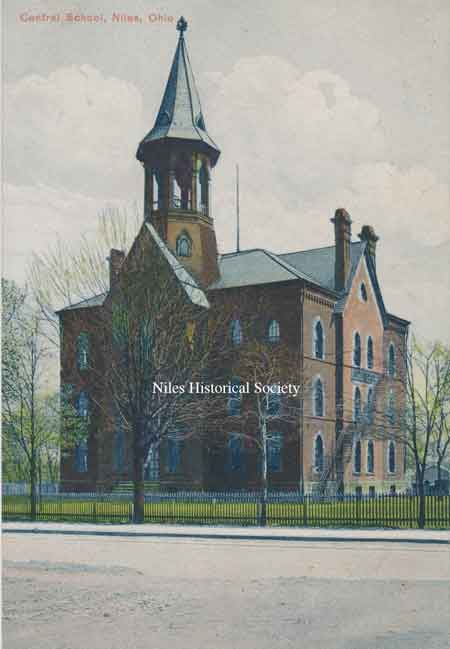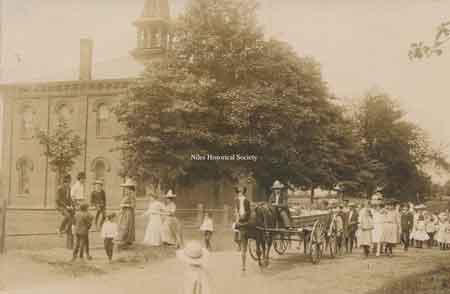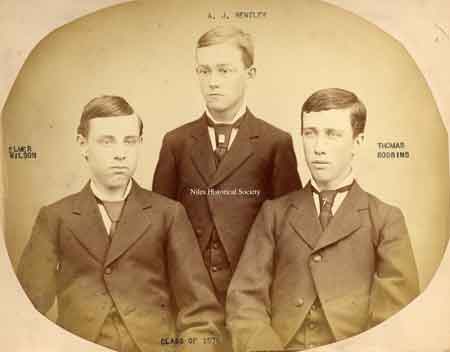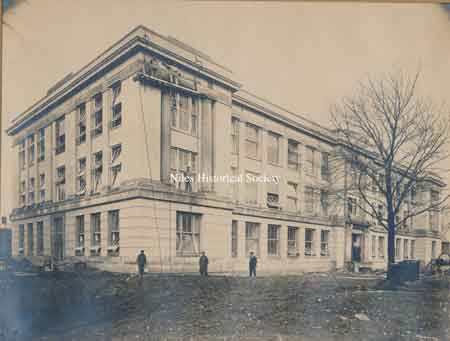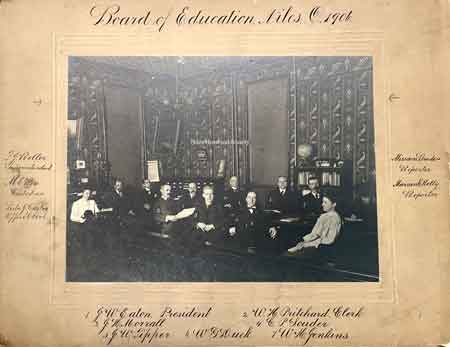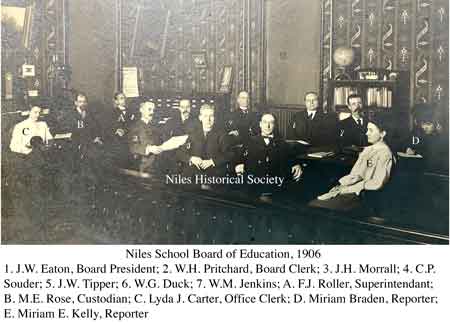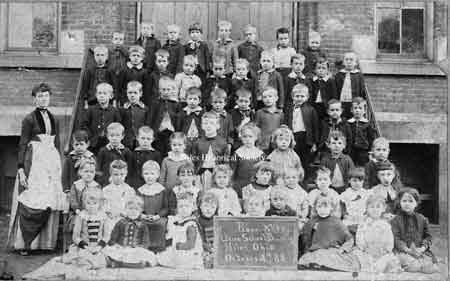Ward-Thomas Museum


Origin of Niles City Schools
Ward — Thomas
Museum
Home of the Niles Historical Society
503 Brown Street Niles, Ohio 44446
Click on any photograph to view a larger image.
News
Tours
Individual Membership: $20.00
Family Membership: $30.00
Patron Membership: $50.00
Business Membership: $100.00
Lifetime Membership: $500.00
Corporate Membership:
Call 330.544.2143
Do you love the history of Niles, Ohio and want to preserve that history and memories of events for future generations?
As a 501(c)3 non-profit organization, your donation is tax deductible. When you click on the Donate Button, you will be taken to a secure Website where your donation will entered and a receipt generated.
|
Frank O. Robbins |
History
of Origin of Niles Schools “In the limited time I have taken to look
up the history of the Niles schools, I have been unable to learn
anything of the actual organization of School District No. 8,
nor have I found anyone who could tell anything of its history
previous to 1842. The earliest record now in existence is a minute
book of the directors’ meetings and the first entry therein
is as follows: This done, the oath of office was administered
by James Dempsy, Esq. Meeting adjourned Friday, September 16th,
1842. WM. McKinley, Clerk. |
|
| |
||
|
Drawing of 'White School House'. |
William McKinley, who signed this record, was the father of our martyred President McKinley, who was born in the following year. I have not been able to learn whether the building known as the ‘White School House,’ standing west of the Presbyterian church, had already been built, but presume that it had. as it is referred to frequently in the records as a meeting place for the directors. At this time teachers were hired for short terms,
three months, or a little longer. Wages varied from $5.50 to $15.00
per month, part to be paid out of the school fund and balance
to be paid in bar iron at a specified price per pupil and to be
furnished by the patrons. There was but one school, ‘the
White Schoolhouse’, in the district at this time, and the
branches taught were thoseof a common English education: writing,
reading, arithmetic, geography and grammar. |
|
| |
||
|
William McKinley's first grade teacher, Miss Sandfordriding in carriage in front of the Allison Hotel, later the Antler Hotel, at the corner of Main Street and Park Avenue.ca 1910. PO11.351 |
It is interesting to note the names of some of the people who either taught the school or who served on the school board: In 1844, we first meet the name of H. H. Mason as director and clerk; in 1845, we find on the Board, the name of J. G. Butler, the father of J. G. Butler, Jr., known to all of our citizens. Under the new school law, in 1849, three directors were elected.In the fall of that year, Amos Allison, H.H. Mason and J. G. Butler. The first instance in the records telling of the hiring of two teachers was in March, 1847; these teachers were Alba Sanford, known to the old citizens as ‘Santa Anna’ and his daughter. Their compensation was $20.00 per month. I can not learn whether they both taught in one building but the presumption is that they did. In the fall of 1851, an enumeration of the white youth over four and under twenty-one in District No. 8, showed that there were within the district 110 males and 92 females between these ages. You will notice that in those days there were no boys and girls, only males and females. In a meeting of the house holders April 12, 1852, held at the White School House, a committee consisting of William Ward, William Hunter and J. G. Butler was appointed to inquire into the propriety of having the school divided and conducted thereafter upon the Union system; we can say nothing relative to this report but it is probable that at this time, the school house later known as the Niles High School, was built at the western end of what was then known as James Street(Church Street). “The Ohio legislature passed a modified
Ohio School Law in 1853. As a result of the new law, the state
collected a uniform property tax across the state, which it then
redistributed to each school district based upon the number of
students enrolled. The Ohio School Law of 1853 also provided money
for school libraries for the first time in Ohio’s history”. |
|
In 1867 there were three schools in District No. 8, one high school taught by Andrew Dienst; the old White School, taught by Miss Olive Allison, now Mrs. George Harris, and one taught by Miss Josie Hardman, either in the old Town Hall or in the old Furnace office, which stood in the southeast corner of the present Union School yard. An election on the Union School law under act passed by the legislature of Ohio in 1849 was held on April 12, 1869 resulted in 102 votes being cast, 101 being for and 1 against. By this vote, the schools within the village of Niles were consolidated and on April 29th, six directors were elected They were Josiah Robbins, Jr., T. C. Stewart, S. D. Young, Col. Wm. Davis, Wm. C. Mann and Wm. Campbell. This board had its first meeting in the Town Hall on the evening of April 30th and organized. On the following day another meeting ofthe Board was held, at which H. H. Mason was present as delegate from Sub-district No. 6 to petition that portion of Sub-district No.6 not within the limits of the corporation of Niles be included in the Union School District. Mr. Mason’s petition was granted. The Niles Union School District in the beginning comprised only the 6th and 8th Districts of Weathersfield Township and was extended with the corporation limits. It was not until about the year 1912 that District No. 9 west of town was taken into the Union School District. On May 4th, 1869, action was taken by the Board to purchase from Mrs. Elizabeth Heaton what was known as the old furnace property, whereon had stood the charcoal furnace built by the Heatons. This was said to be the second iron industry in the state and first in the Mahoning Valley. At a meeting of the qualified voters ofthe District, held on the evening of Saturday. May 22, 1869, it was unanimously resolved that the Board of Directors be empowered to purchase a site and erect thereon a suitable school house and authority was granted to levy a tax of $15,000.00 on the District for this purpose.
|
||
| |
||
|
|
||
|
This photograph is not Central High School as was first thought. ca 1895. PO1.1221 1878 graduating class: Elmer Wilson, A.J. Bentley, Thomas Robbins. PO1.1613 |
In September, 1869, Rev. T. 0. Stewart was selected by the Board as first Superintendent or acting manager of the Niles Union Schools. On March 1, 1870. the electors of the District empowered the Board to make an additional levy of $10,000.00, as the Board had found that at least $25,000.00 would be required to erect a building suitable for the needs of the District. On May 18, 1870, the Board let the contract for
the Union School building to a Cleveland firm of contractors for
the sum of $27,950.00, payment to be made in 8 per cent bonds. The first Board meeting in the new school building was held on March 10, 1871, and the building was accepted May 24, 1871. In the new building, the High School occupied the entire west side ofthe second floor and continued to occupy that room until the holiday season of 1888, when the crowded conditions ofthe schools necessitated abandoning the third floor as a ‘Union Hall’ and converting it into school rooms. L.L. Campbell was elected Superintendent April 24, 1871. He was succeeded by Miss Stewart in the fall of 1875, whose occupancy lasted only two terms. She was succeeded by Mr. Hitchcock in the spring of 1870. Mr. Hitchcock was succeeded as Superintendent in the fall of 1879 by Mr. Bulla, who served until 1883 when he was succeeded by Mr. Wight. In 1888 Mr. Wight was succeeded by Mr. Roller, who guided so ably and satisfactorily the affairs ofthe Niles schools for 22 years. He was followed by Mr. W. C. Campbell, the present Superintendent (1915). Under Mr. Campbell’s efficient management,
the Niles Union Schools are rendering a great service to the youth
of the community and occupy a front rank among the schools of
the state. There is an enrollment at present of 1752 pupils, of
whom 240 are members of the High School and 120 are in the grammar
grades. These 360 now occupy the Central building. This building
for ten years has been condemned by the state authorities as unsanitary
and as a veritable fire trap. |
|
| On May 12, 1913, an election was held on the question of a bond issue of $195,000.00 at 4-1/2, per cent, for a new High School building and for improvements on two of the Ward buildings.The election carried, there being 427 votes for the issue and 203 against. Later the Board purchased the present site for the new school for approximately $40,000.00, and on July 6, 1914, ground was broken for this fine High School building which will cost complete, ready for occupancy, approximately $160,000.00. Ed. This McKinley High School later became Edison Jr. High School.
Central High School had several classroom fires and was torn down in the early 1920s. In 1928, Central Park with a pavillion and wading pool was dedicated. |
||
| Development Of Niles
School System From 1871 Until the Present Time(1934).
Six Teachers In 1871; Four Schools Here
In 1890. Six Teachers Staff Increases Enrollment Grows The above table indicates that school enrollment increased gradually until 1912, since when it has increased more than 195%. The largest proportionate increase has occurred at the high school, where as late as 1906, the enrollment was but 78, and the largest graduating class 18 in number, as compared with a high school enrollment of 1210 and a graduating class of 181 in 1834. 4 Schools in 1890 5th School Added Present Niles Schools Modern Curriculum Interests Differ Sometimes, however, the program was of a social nature as when on January 1, 1886, the literary society entertained at a social held in the Falcon skating rink. The literary programs were good preparation for graduation, as each member of the graduating class was expected to give a commencement oration upon some patriotic or other lofty subject It was an age when reform movements, dissipated
by the Civil War, were again gathering strength. In 1886, the
entire school population ‘took the pledge’ in writing,
to abstain from use of tobacco or liquor, and to cultivate ‘clean
and pure living.’ |
||
|
|
|
